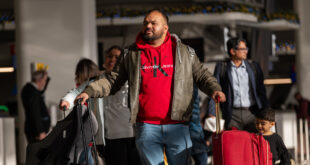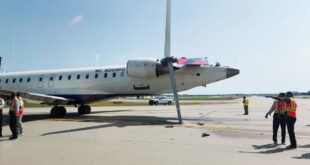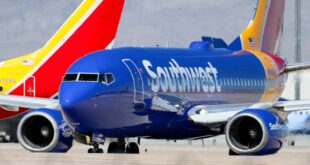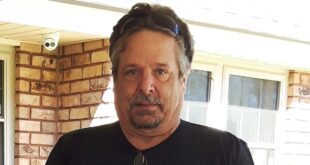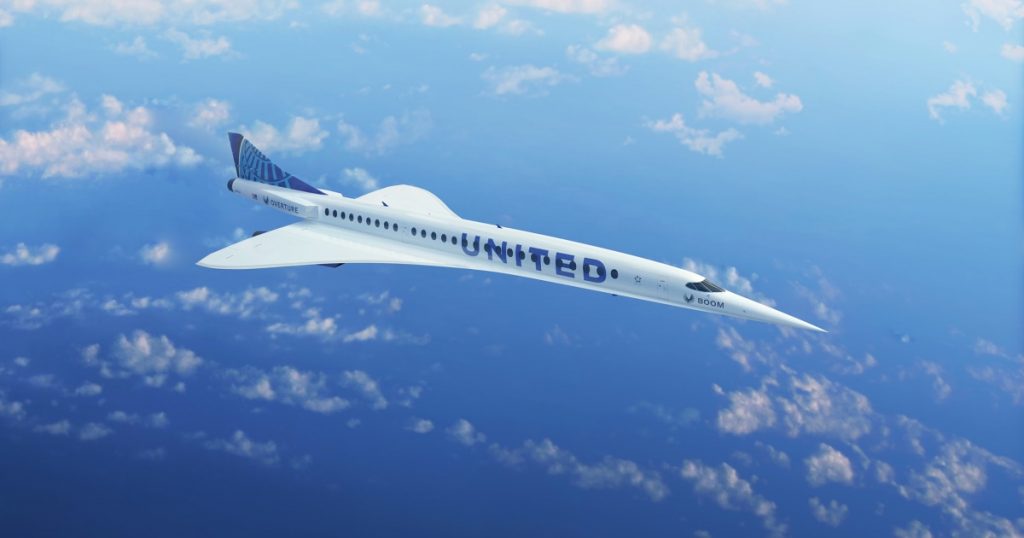

United Airlines announced Thursday that it has ordered 15 supersonic planes from startup Boom Supersonic — saying it hopes to zip travelers around the globe in half the time, for the price of a current first-class ticket.
That’s Newark, New Jersey, to London in 3½ hours and San Francisco to Tokyo in six hours, for about $5,000 to $7,000.
But don’t rush out to book a fare just yet. These flights won’t be operational before 2029 at the earliest.
“By the end of the decade,” Blake Scholl, CEO of Boom, which is based in Denver, said of the timeline for the aircraft, which has been dubbed the Overture. “We want to do supersonic as quickly as possible. We think the world needs this.”
Scholl, who was a Groupon product manager and a manager at Amazon, said he started the company in his basement with a spreadsheet and a dream. “Travel is a fundamental human good,” he said. “It’s better to live life in person.”
The new planes will be carbon neutral and use sustainable air fuel, currently priced at up to eight times traditional petroleum-based jet fuel.
Scholl said that while he doesn’t have a background in aerospace, he has flown small planes for fun. To pull off the details, he hired and partnered with some of the best minds, including a lead engineer who formerly worked for SpaceX, and team members who helped build Gulfstream jets and engines by Rolls-Royce.
“I found that passion and drive trumped knowledge and wisdom,” he said.
United and the rest of the aviation industry are eager for a new story to tell after an exceptionally bad year during the coronavirus pandemic.
As lockdowns and corporate travel prohibitions slashed demand, passenger totals fell from all-time highs of over 2 million a day to under 100,000.
Along with other airlines, United received government funds to prop up employee salaries during the savage downturn, including a $3.5 billion grant and a $1.5 billion loan.
The new contract calls for United to pay $3 billion for 15 planes, with an option to add up to 50 more.
United, excited about the possibilities, ran a video on Instagram proclaiming “supersonic is here” to a throbbing hip-hop beat.
“At 60,000 feet with big windows, it’s going to be an amazing experience,” said Mike Leskinen, the airline’s vice president for corporate development.
“If we take off in London just after sunset, you’ll be able to watch the sun rise in the west as you get back to New York City,” he said.
The possibilities of supersonic travel are even on the mind of President Joe Biden.
“I tell the kids … when I go on college campuses they’re going to see more change in the next 10 years than we’ve seen in the last 50 years,” he said at the unveiling of the American Jobs Plan in April. “We’re going to talk about commercial aircraft flying at … supersonic speeds. Be able to … traverse the world in about an hour, travel 21,000 miles an hour. So much is changing. We have got to lead it.”
Airline industry experts say the move may mostly be about United’s telling the world that it has a vision for the future.
Most purchase contracts don’t take much money to maintain the position, and real money has to be spent only when a plane is ready, said Adam Pilarski, an aviation consultant with Avitas of Virginia. So far, the commercial version of the plane hasn’t been built or certified by the Federal Aviation Administration.
“It’s a low-cost, feel-good, positive step,” Pilarski said. “It shows the public we are in it for the long run.
“We don’t know where the plane will actually go,” he added. “We don’t know the range. But sure, we are talking about the future, and that’s good.”
The previous trans-Atlantic supersonic commercial airliner, the Concorde, which shut down in 2003, had $12,000 tickets and could barely break even after the British and French governments helped foot the development bill.
“The number of seats per day were in the low thousands” for business and first-class travel between London and New York, said Bob Mann, founder of the aviation analytics and consulting firm R.W. Mann & Co. “Are you going to displace all that traffic to supersonic, or will you fly two a day that British Airways flew to London, which could rarely fly full except with upgrades?”
“The jury will be out for 10 years. And it may turn out it was a pie-in-the-sky dream,” he said.
The investment could pay off more if supersonic jets could fly over land. Noise and complaints from homeowners limit where the planes can fly, owing to the sonic boom produced to fly faster than the speed of sound.
The aviation startup says it is working on technology to do just that. Boom and United hope to reach that goal eventually and hope economies of scale will lower the cost of supersonic travel to be affordable to the global masses.
“The future is going to be supersonic flight everywhere,” Scholl said. “And imagine being able to cut that, you know, Seattle-to-D.C. flight in half. That’s going to happen.”
Boom is one of several startups vying for the lead in supersonic aircraft development. A previous front-runner, Aerion, which was backed by Boeing, folded in late May, citing fundraising challenges, even though it had pre-order agreements with the private jet company NetJets, owned by billionaire Warren Buffet’s Berkshire Hathaway.
CORRECTION (Aug. 16, 2022, 8:24 p.m. ET): A previous version of this article misstated the name of the aviation company. It is Boom Supersonic, not Boom Aviation.
 Latest Breaking News Online News Portal
Latest Breaking News Online News Portal


